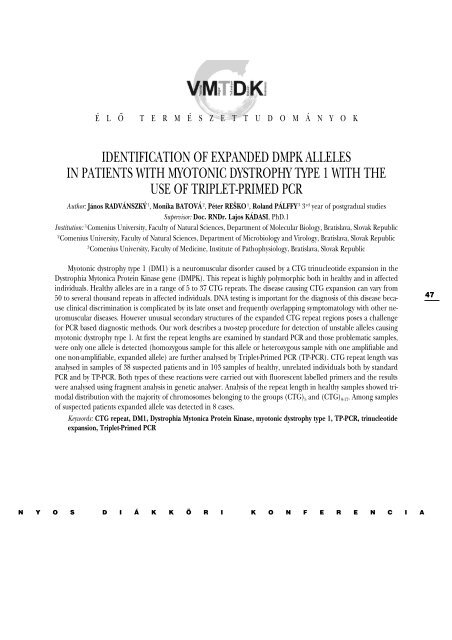Rezümékötet 2008. - vmtdk
Rezümékötet 2008. - vmtdk
Rezümékötet 2008. - vmtdk
You also want an ePaper? Increase the reach of your titles
YUMPU automatically turns print PDFs into web optimized ePapers that Google loves.
É L Õ T E R M É S Z E T T U D O M Á N Y O K<br />
IDENTIFICATION OF EXPANDED DMPK ALLELES<br />
IN PATIENTS WITH MYOTONIC DYSTROPHY TYPE 1 WITH THE<br />
USE OF TRIPLET-PRIMED PCR<br />
Author: János RADVÁNSZKÝ 1 , Monika BATOVÁ 2 , Péter REŠKO 1 , Roland PÁLFFY 3 3 rd year of postgradual studies<br />
Supervisor: Doc. RNDr. Lajos KÁDASI, PhD.1<br />
Institution: 1 Comenius University, Faculty of Natural Sciences, Department of Molecular Biology, Bratislava, Slovak Republic<br />
2 Comenius University, Faculty of Natural Sciences, Department of Microbiology and Virology, Bratislava, Slovak Republic<br />
3 Comenius University, Faculty of Medicine, Institute of Pathophysiology, Bratislava, Slovak Republic<br />
Myotonic dystrophy type 1 (DM1) is a neuromuscular disorder caused by a CTG trinucleotide expansion in the<br />
Dystrophia Mytonica Protein Kinase gene (DMPK). This repeat is highly polymorphic both in healthy and in affected<br />
individuals. Healthy alleles are in a range of 5 to 37 CTG repeats. The disease causing CTG expansion can vary from<br />
50 to several thousand repeats in affected individuals. DNA testing is important for the diagnosis of this disease because<br />
clinical discrimination is complicated by its late onset and frequently overlapping symptomatology with other neuromuscular<br />
diseases. However unusual secondary structures of the expanded CTG repeat regions poses a challenge<br />
for PCR based diagnostic methods. Our work describes a two-step procedure for detection of unstable alleles causing<br />
myotonic dystrophy type 1. At first the repeat lengths are examined by standard PCR and those problematic samples,<br />
were only one allele is detected (homozygous sample for this allele or heterozygous sample with one amplifiable and<br />
one non-amplifiable, expanded allele) are further analysed by Triplet-Primed PCR (TP-PCR). CTG repeat length was<br />
analysed in samples of 38 suspected patients and in 103 samples of healthy, unrelated individuals both by standard<br />
PCR and by TP-PCR. Both types of these reactions were carried out with fluorescent labelled primers and the results<br />
were analysed using fragment analysis in genetic analyser. Analysis of the repeat length in healthy samples showed trimodal<br />
distribution with the majority of chromosomes belonging to the groups (CTG) 5 and (CTG) 9-17. Among samples<br />
of suspected patients expanded allele was detected in 8 cases.<br />
Keywords: CTG repeat, DM1, Dystrophia Mytonica Protein Kinase, myotonic dystrophy type 1, TP-PCR, trinucleotide<br />
expansion, Triplet-Primed PCR<br />
N Y O S D I Á K K Ö R I K O N F E R E N C I A<br />
47




